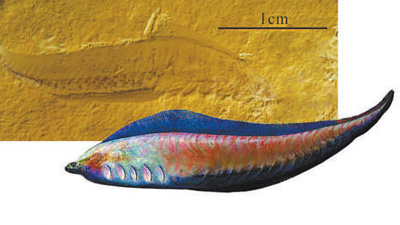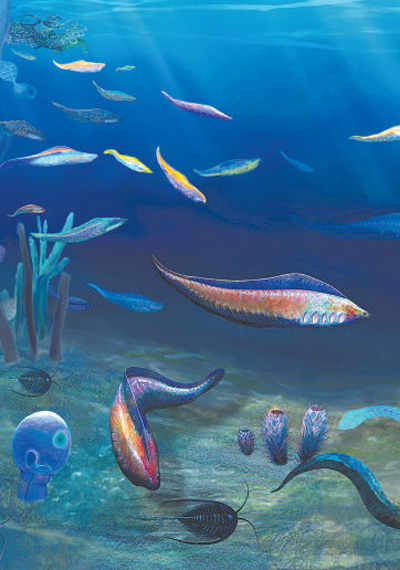 |
Kunming Fish Fossil of Fengjiao and Its Restoration Map. |
 |
The "first fish" in the early Cambrian ocean and the restoration map of its neighbors.
The above pictures are provided by Shudegan |
In the vast universe, there are few "lucky" planets like Earth: she has maintained the "just right" liquid hydrosphere and oxygen atmosphere for 4 billion years in a row, and finally evolved into human beings. In the long history, human beings have been trying to find their own source, resulting in many myths and legends. In the middle and late 19th century, Darwin's theory of evolution changed human's view of nature and world. In the following 150 years, academia continued to track the origin of human beings based on the theory of evolution. In the narrow sense, the complete fossil sequence of human ancestors from apes to humans has been preliminarily determined and recognized in Africa and Asia. And before that? What are the ancestors of human ancestors like? As paleontologists, we hope to continue to explore the source according to the "clues" of fossils.
Tracing the process of life evolution from "homologous structure"
In 1859, Darwin's Origin of Species changed people's understanding of the relationship between man and nature. Twelve years later, Darwin published The Origin and Sexual Selection of Human Beings, and analyzed in detail the morphological and anatomical characteristics of human beings and lower vertebrates and the evidence of comparative embryology. Finally, he concluded that many organs of human beings and all other vertebrates (such as fish, amphibians, reptiles and mammals) have a common source, namely "homologous structure", Therefore, humans and lower vertebrates share a common ancestor. Of course, Darwin did not know when and by which early ancestors those most basic homologous structures appeared. Fortunately, through the unique scientific window of Chengjiang Fauna, Chinese scholars have found key evidence after long-term exploration.
At the beginning of this century, biologists, based on molecular genetic information, traced the ancestors of all generations shared by human beings and all biological groups on the earth from near to far, and it can be determined that there have been 40 generations. According to DNA information, humans and modern chimpanzees are closely related. Using molecular clock technology, we can calculate that humans and chimpanzees shared a common ancestor 6 million years ago, that is, the first meeting point; Continue to search for ancestors, and reach the second meeting point 8 million years ago, that is, meet the penultimate common ancestor. By analogy, humans and their relatives, including lampreys, have reached the 22nd meeting point 520 million years ago, where they can meet the important discovery of Chengjiang fauna - the "first fish", the Fengjiao Kunming fish. Finally, human beings and all living things on the earth can trace back to the ultimate ancestor 4 billion years ago, and reach the 40th meeting point, which is the common ancestor of all life - primitive true bacteria. This ancestral story sounds interesting, but most of them lack true fossil records.
However, in about 42 million years ago, 560 million to 518 million years ago, the most spectacular biological innovation event in the entire life history, the Cambrian explosion, occurred, that is, 90% of the animal groups were born in less than 1% of the time of the earth's history. A large number of animal fossils provide important specimens for tracing animal evolution and human ancestors. The Fengjiao Kunming fish mentioned above lived at the peak of the Cambrian explosion.
After the Cambrian explosion, the earth entered the "three pole ecosystem"
The Ediacara biota at the end of the Precambrian period (about 560 million to 540 million years ago), the small shelled fauna at the beginning of the Cambrian period (about 540 million to 520 million years ago), and the Chengjiang fauna in China's Yunnan province (about 520 million to 518 million years ago), which are widely distributed around the world, constitute three treasure houses of early rare fossils in the world, providing key evidence for understanding the Cambrian life explosion. The Cambrian explosion constituted the watershed of the evolution of the earth's ecosystem: 540 million years ago, life on the earth was basically maintained in the bipolar ecosystem, that is, only producer algae and decomposer bacteria, and there were almost no real consumer animals; After tens of millions of years of the Cambrian explosion, a complete tripartite animal kingdom was quickly created in the Chengjiang fauna period, and the earth has entered the tripolar ecosystem since then, and has been continuing to this day.
The essence of the Cambrian explosion is the explosion of animal innovation, not the "species explosion" that people thought in the past. As we all know, the earth animal kingdom includes millions of existing species, which can be classified into nearly 40 categories. All these taxa are usually grouped into three sub kingdoms: the lower basic animal sub kingdom, including jellyfish and corals; The higher protostome sub kingdom, including most animal phyla such as Arthropoda and Mollusca; The higher metazoan sub kingdom includes the well-known echinoderma and vertebrates. According to research, during the Cambrian explosion, more than 20 major animal phyla were rapidly born in three batches, forming three sub worlds from quantitative change to qualitative change, forming a complete "first animal tree" framework. This is the "three episode Cambrian eruption hypothesis" put forward by Chinese scholars and reached basic consensus in the paleontological community.
The driving forces of the outbreak of the phylum of animals include internal and external factors. The internal cause is mainly the evolution and innovation of genes, especially the rapid step shaping of homologous gene strings. The number of genes contained in homologous gene strings of each phylum is different from each other. The number of genes with homologous gene strings is relatively small in each phylum of basic animal subkingdom; It can increase to about 10 in each phylum of Protostome subfamily; There can be as many as 14 in each phylum of the suborder of chostomate. Homologous gene string is a total regulatory gene that controls the development of animal embryos, and it determines the basic characteristics of the morphological structure of various animal classes. In addition, various predatory levels within the animal kingdom are rapidly forming, "big fish eat small fish, small fish eat shrimp", and increasingly fierce predatory competition will also accelerate the rate of animal evolution. The external cause of the outbreak of the fauna is mainly due to the Earth's second great oxidation event about 520 million years ago, which greatly increased the oxygen content of the sea and met the needs of a large number of animals for survival and reproduction; In addition, a large amount of life elements such as phosphorus and calcium are enriched in the ocean, which further aggravates the intensity of the animal phyla outbreak.
Milestone "Catch the First Fish"
Half a century before Darwin founded the theory of evolution, Lamarck, the early founder of the theory of evolution, proposed that animals can be divided into two super families: vertebrates and invertebrates, and the lowest vertebrates are gradually evolved from invertebrates. For more than 200 years, scientists have been searching for real evidence of this evolutionary process.
In the fossil treasure house of Chengjiang fauna, scientists have obtained reliable evolutionary evidence: Paleozoa pioneered the primitive branchial cleft, which opened the respiratory system revolution leading to the four "branchial cleft" phyla of echinoderms, hemichords, Yunnan worms and chordates; Then the lower chordal animals, the Chinese eel and the Yangtze sea squirt, pioneered the original chordal cord and related muscle segments, thus starting the revolution of the motor system; Finally, the brain eyes, vertebrae and heart structures of the "first fish" Haikou fish and Fengjiao Kunming fish show that they have achieved a revolution in the nervous system and circulatory system and successfully completed a major upgrade of metabolism. The above several key organ creations have laid a solid foundation for the human body configuration 500 million years later. In particular, the discovery of the "first fish" has solved two major problems that have long been outstanding in the academic community: first, it declared that the Earth's "first animal tree" was born at the climax of the Cambrian explosion; The second is to empirically solve the problem of the stepwise origin of vertebrates, and recognize the true appearance of the ancestor of human beings who pioneered the brain eye and vertebrae.
After the Cambrian explosion, there were five times of organ transformation or improvement before the birth of human beings. For the first time, the transformation of the gill cleft made the ungnathian animals evolve to the jawed ones, so that they can feed actively; The second time, from the balance of even fin swimming to quadruped landing walking; The third time, from the egg without amnion to the egg with amnion; For the fourth time, hair grew from egg to fetus and lactation; The fifth time, from four legs to two legs, from mammalian brain to human brain. Five organ transformations are the main stage of evolution from lower vertebrates to humans, but obviously, the fundamental evolution from zero to one, from nothing to existence, is reflected in the leap from headless and invertebrate to headless and vertebrate. Therefore, the discovery of "the first fish" is of great milestone significance. "The First Fish" has become an important achievement of the annual "First Prize of the National Natural Science Award". The papers on the discovery of "the First Fish" and its related groups have been published in Nature, Science and other international top academic journals for many times. Nature magazine highly praised the discovery with the title of "Catching the First Fish". At present, Haikou Fish, Fengjiao Kunming Fish and other "first fish" related materials have been widely selected into textbooks, encyclopedias and museums in various countries.
Paleontology research is a kind of research of looking for a needle in a haystack. It may take decades to meet a good specimen. Undoubtedly, there is necessity behind contingency, and good luck often favors a prepared mind. At present, China's paleontology research is in the first place in the world, thanks to our unique fossil pools of Chengjiang Fauna, Rehe Biota, Lantian Biota, Weng'an Biota, Adikala Biota of the Three Gorges, Silurian Vertebrate Fauna, etc., and also because we have a high-quality team of paleontology research talents. Paleontology is a science about life history, similar to history in nature. We study history because it helps human beings gain experience in social foothold and development; In the same way, we should learn and understand paleontology, because it can help human beings to make continuous progress in co evolution with nature.
(The author is an academician of the Chinese Academy of Sciences and a professor of Northwestern University)
Format design: Shen Yiling
Recommended Readings
The Origin of Human Beings and Sexual Selection: Darwin, translated by Ye Duzhuang and Yang Xizhi; Published by Peking University Press.
The Ancestor of Humans in the Outbreak of Hanwu: written by Shu Degan's team; Published by Northwest University Press.
The Story of Ancestors: written by Richard Dawkins and Huang Keren, translated by Xu Shiming and Guo Yunbo; Published by CITIC Press.
People's Daily (April 12, 2024, 20th Edition)
(Editor in charge: Hu Yongqiu, Yang Guangyu)
Share to let more people see






































